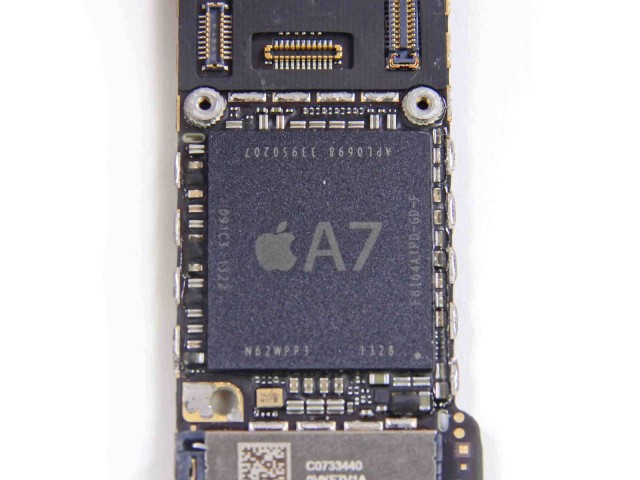
Apple released iOS 8.1 to the public today, but it delivered something else to developers too. As of February 1, 2015 Apple will require all App Store submissions to include 64-bit support and to be built with the iOS 8 SDK.
If you've got an older iPhone or iPad (anything with an Apple A5 or A6 chip in it) this announcement means nothing to you. Like their OS X counterparts, 64-bit iOS apps can be distributed as universal binaries that support both 32- and 64-bit processors. 9to5Mac also reports that existing 32-bit apps will remain in the App Store. Only developers submitting new apps or updates to existing apps will need to comply with the new rules. Apple is usually fairly aggressive about mandating use of its latest developer tools. It required developers to switch to Xcode 5 and comply with iOS 7's new design rules in February of 2014—for older devices, this is just business as usual.
If you've got a 64-bit device, though, you may stand to get significant performance boosts to your apps. Remember, for ARM processors the move to 64-bit isn't just about addressing more RAM—64-bit ARM chips come with a new ARMv8 instruction set that cleans up some of the cruft found in ARMv7. Our benchmarks estimate that an Apple A7 can run 64-bit code up to 30 percent faster than it runs 32-bit code. An A8 can be as much as 40 percent faster.
64-bit chips now power a fairly large chunk of the iOS lineup. The Apple A7 can be found in the iPhone 5S, iPad Air, iPad Mini 2, and iPad Mini 3. The Apple A8 ships in the iPhone 6 and 6 Plus, and a new more-powerful A8X variant was introduced in the iPad Air 2. That's a pretty big pool of devices that can take advantage of ARMv8, but as of this writing many applications still haven't followed. We took a look at a list of common applications in our iPhone 6 review, and we've updated that same table to account for apps that have been updated for iOS 8 and the new phones.
| App | Status in May 2014 | Status in September 2014 | Status in October 2014 |
|---|---|---|---|
| Dropbox | 32-bit | 64-bit | 64-bit |
| Google Chrome |
32-bit | 32-bit | 64-bit |
| Google Drive | 32-bit | 32-bit | 32-bit |
| Google Sheets |
32-bit | 32-bit | 32-bit |
| Google Docs |
32-bit | 32-bit | 32-bit |
| Gmail | 32-bit | 32-bit | 32-bit |
| Google Maps | 32-bit | 32-bit | 32-bit |
| YouTube | 32-bit | 32-bit | 32-bit |
| 32-bit | 32-bit | 32-bit | |
| Office Mobile |
32-bit | 32-bit | 32-bit |
| OneNote | 32-bit | 32-bit | 32-bit |
| 32-bit | 32-bit | 32-bit | |
| Tweetbot 3 |
64-bit | 64-bit | 64-bit |
| Downcast | 32-bit | 64-bit | 64-bit |
| 32-bit | 32-bit | 32-bit | |
| Kindle | 32-bit | 32-bit | 32-bit |
| Spotify | 32-bit | 32-bit | 32-bit |
| Netflix | 32-bit | 32-bit | 32-bit |
| Hulu | 32-bit | 32-bit | 32-bit |
| Amazon Instant Video |
32-bit | 32-bit | 32-bit |
| Bugshot | 64-bit | 64-bit | 64-bit |
| Vesper | 64-bit | 64-bit | 64-bit |
| Vine | 32-bit | 32-bit | 32-bit |
| Slack | 32-bit | 64-bit | 64-bit |
| Amazon | 32-bit | 32-bit | 32-bit |
| Fandango | 32-bit | 32-bit | 32-bit |
| 32-bit | 32-bit | 32-bit | |
| Mailbox | 32-bit | 32-bit | 64-bit |
| Fleksy | 64-bit | 64-bit | 64-bit |
| Untappd | 32-bit | 32-bit | 64-bit |
| Instapaper | 32-bit | 64-bit | 64-bit |
Apps slowly continue to make the transition, and at least a few developers have taken the opportunity to go 64-bit as they have updated their apps for iOS 8 and the iPhone 6. Although Chrome is the only one of Google's apps that has made the jump, it suggests that the rest of them will follow before too long. Dropbox's Mailbox app and the Untappd beer tracking app have picked up support in the last month as well. Major holdouts include anything by Microsoft, most media playing apps (Netflix, Hulu, Spotify, Amazon Instant Video, and on), and Facebook (even though that app just got an iPhone 6 update recently).
iOS developers have had 13 months to get on the 64-bit train, and they've only recently started doing it—to be fair to them, though, they've also needed to adjust to iOS 7's new design, iOS 8's new APIs and Extensions, and the new screens on the iPhone 6 and 6 Plus. It's a lot to take in. In any case, this problem will go away in another three months or so, mostly to the benefit of those using newer iPhones and iPads.
Reader Comments (140)
View comments on forumLoading comments...